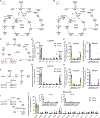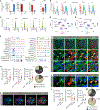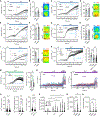LDHB contributes to the regulation of lactate levels and basal insulin secretion in human pancreatic β cells
- PMID: 38607916
- PMCID: PMC11164428
- DOI: 10.1016/j.celrep.2024.114047
LDHB contributes to the regulation of lactate levels and basal insulin secretion in human pancreatic β cells
Abstract
Using 13C6 glucose labeling coupled to gas chromatography-mass spectrometry and 2D 1H-13C heteronuclear single quantum coherence NMR spectroscopy, we have obtained a comparative high-resolution map of glucose fate underpinning β cell function. In both mouse and human islets, the contribution of glucose to the tricarboxylic acid (TCA) cycle is similar. Pyruvate fueling of the TCA cycle is primarily mediated by the activity of pyruvate dehydrogenase, with lower flux through pyruvate carboxylase. While the conversion of pyruvate to lactate by lactate dehydrogenase (LDH) can be detected in islets of both species, lactate accumulation is 6-fold higher in human islets. Human islets express LDH, with low-moderate LDHA expression and β cell-specific LDHB expression. LDHB inhibition amplifies LDHA-dependent lactate generation in mouse and human β cells and increases basal insulin release. Lastly, cis-instrument Mendelian randomization shows that low LDHB expression levels correlate with elevated fasting insulin in humans. Thus, LDHB limits lactate generation in β cells to maintain appropriate insulin release.
Keywords: CP: Metabolism; GC-MS; LDH; NMR; glucose tracing; imaging; islet; lactate; metabolism; pyruvate; pyruvate dehydrogenase.
Copyright © 2024 The Authors. Published by Elsevier Inc. All rights reserved.
Conflict of interest statement
Declaration of interests G.A.R. has received grant funding from, and is a consultant for, Sun Pharmaceuticals Industries Ltd. D.J.H. receives licensing revenue from Celtarys Research for provision of chemical probes. D.J.H. has filed patents related to type 1 diabetes and type 2 diabetes therapy, unrelated to the present study.
Figures




References
-
- Henquin JC (2000). Triggering and amplifying pathways of regulation of insulin secretion by glucose. Diabetes 49, 1751–1760. - PubMed
Publication types
MeSH terms
Substances
Grants and funding
LinkOut - more resources
Full Text Sources
Molecular Biology Databases
Miscellaneous

